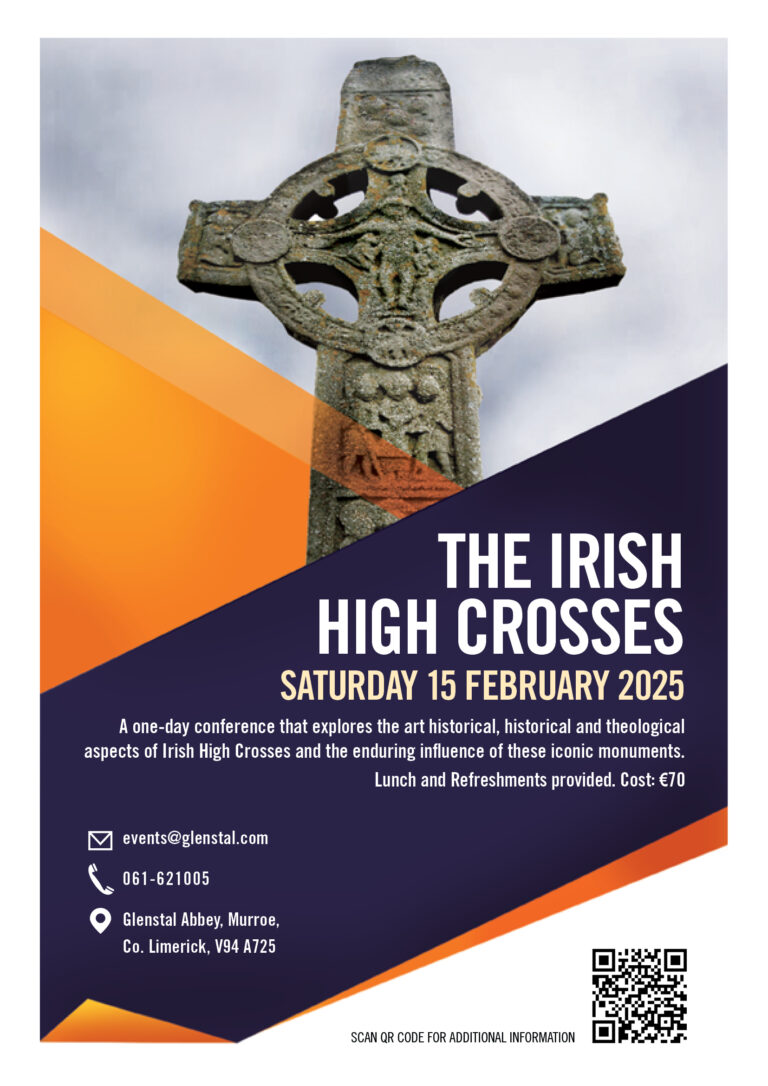
As the central symbol of the Christian faith, the Cross has been depicted in a variety of ways by artists since the early Christian period. This one-day conference taking place on Saturday 15th February 2025 explores how Irish sculptors and artists have portrayed the key instruments of Christ’s passion in the millennium between the seventh and the seventeenth centuries. The contributors will examine the art historical, historical and theological aspects of the Irish High Crosses and will trace the enduring influence of these iconic monuments.
- Registration: 9.30 to 10am
- Session 1: 10am –10.45pm
Form, Contexts and Functions of the Irish High Crosses with Dr Megan Henvey. - Session 2: 11.10–12 noon
The Iconography of Irish High Crosses with Professsor Rachel Moss. - 12.10pm Conventual Mass followed by lunch.
- Session 3: 2.20–3.10pm
The Cross in Late Medieval Ireland with Br Colmán Ó Clabaigh OSB. - Session 4: 3.45–4.30pm
The Afterlives of Medieval Crosses with Professor Rachel Moss.
The iconic form of Ireland’s early medieval, free-standing, stone-carved crosses has long captured the imagination of antiquarians, scholars, and the general public, alike. Through a case-study of what has been considered the earliest high cross – the Carndonagh Cross (Co. Donegal) – this paper will: provide an overview of research methods applied to the crosses to-date; consider some new evidence to better understand the chronology and morphology of the development of this unique monument type; and show how individualised study of these monuments may reveal both their original function, and their important role in the development of Christian belief and theology of the period.
This paper will present an introduction to the often complex iconography of the Irish High Cross. It will examine some of the more popular biblical themes, viewed in the broader context of early Christian art, before turning to some of the more puzzling figures that present greater challenges in interpretation.
Irish society and the Irish church experienced radical transformation from the twelfth century onwards. This presentation traces how these developments were reflected in the form and function of the crosses erected during the period from the twelfth to the fifteenth centuries. It will demonstrate how the form and iconography of these crosses reflected contemporary theological and political developments alongside changing expressions of faith and devotion.
The 150 years that followed the Reformation was a turbulent period in Irish religious history. This paper examines the fortunes of medieval crosses in Ireland during the period c. 1540-1690. It looks at how a confessionally divided society regarded the monumental cross on the one hand as an enduring symbol of commerce and civic obedience and on the other as a tangible link to the saints and centuries of Roman Catholic devotion. Examples of crosses that were destroyed, moved or reconstructed during this period will demonstrate the ever changing fortunes of some of Ireland’s best known stone crosses.
Megan Henvey is an Associate Fellow in the Department of History of Art at the University of York, where she also completed her AHRC-funded and Stanford Text Technologies- supported doctorate in 2021. Her multi-disciplinary research employs the historical, literary, liturgical, archaeological, art historical, and geological evidence to explore early medieval Christian communities in Ireland, their pan-geographic networks, and the relationships between regional iconographies and Christian beliefs in the early Middle Ages, with wider research interests including the nature of borders and their function and value in the classification of material heritage.
Rachel Moss is Professor in the History of Art and Architecture at Trinity College Dublin. She specialises in the medieval art and architecture of Ireland. Her current research focusses on the extended biography of medieval objects and buildings, examining how the uses and meanings of medieval material culture has altered over time.
Colmán Ó Clabaigh is a monk of Glenstal and a medievalist specialising in the monastic and religious history of Late Medieval Ireland on which he has published extensively. His current research focusses on the social impact of religion in Ireland between the twelfth and the sixteenth centuries.

